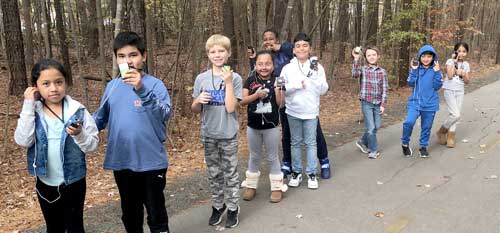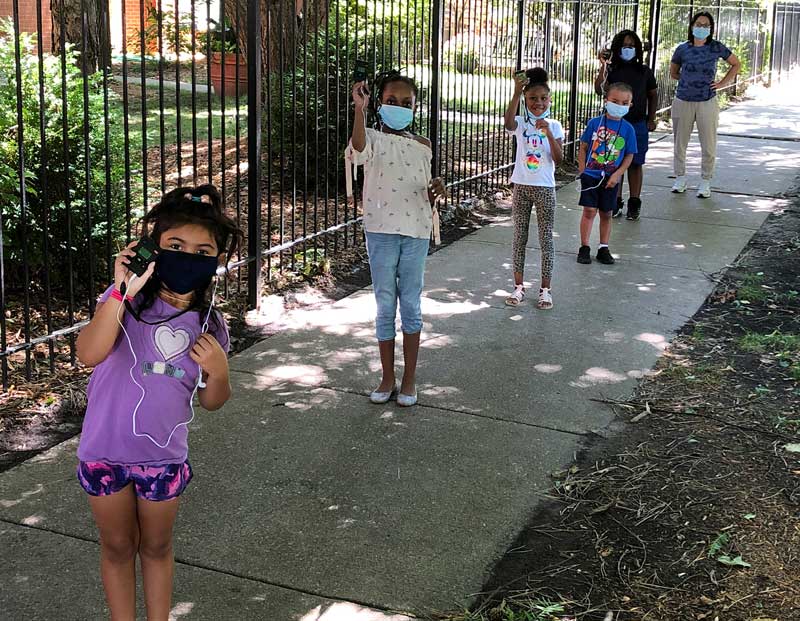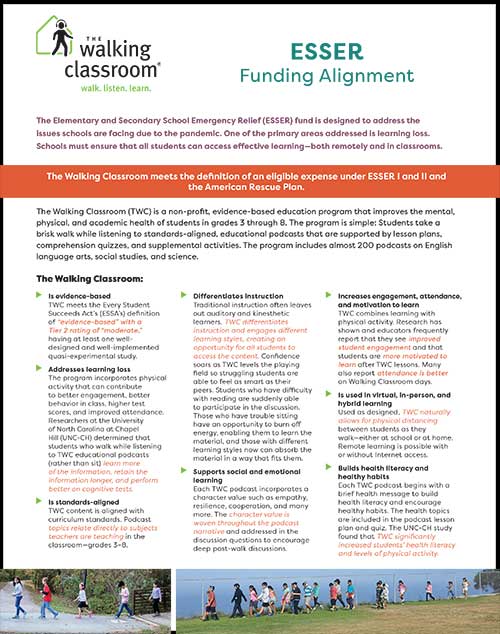This guide identifies The Walking Classroom program alignment with the Elementary and Secondary School Emergency Relief Fund (ESSER Fund) and the American Rescue Plan (ARP), under the Coronavirus Aid Relief and Economic Security (CARES) Act.
The ESSER fund is designed to address the issues schools are facing due to the pandemic. One of the primary areas addressed is learning loss. Schools must ensure that all students can access effective learning—both remotely and in classrooms.
The Walking Classroom meets the definition of an eligible expense under ESSER I and II and the American Rescue Plan.
The Walking Classroom (TWC) is a non-profit, evidence-based education program that improves the mental, physical, and academic health of students in grades 3 through 8. The program is simple: Students take a brisk walk while listening to standards-aligned, educational podcasts that are supported by lesson plans, comprehension quizzes, and supplemental activities. The program includes almost 200 podcasts on English language arts, social studies, and science.
The Walking Classroom:
- Is evidence-based
TWC meets the Every Student Succeeds Act’s (ESSA’s) definition of “evidence-based” with a Tier 2 rating of “moderate,” having at least one well-designed and well-implemented quasi-experimental study.
- Addresses learning loss
The program incorporates physical activity that can contribute to better engagement, better behavior in class, higher test scores, and improved attendance. Researchers at the University of North Carolina at Chapel Hill (UNC-CH) determined that students who walk while listening to TWC educational podcasts (rather than sit) learn more of the information, retain the information longer, and perform better on cognitive tests.
- Is standards-aligned
TWC content is aligned with curriculum standards. Podcast topics relate directly to subjects teachers are teaching in the classroom—grades 3–8.
- Differentiates instruction
Traditional instruction often leaves out auditory and kinesthetic learners. TWC differentiates instruction and engages different learning styles, creating an opportunity for all students to access the content. Confidence soars as TWC levels the playing field so struggling students are able to feel as smart as their peers. Students who have difficulty with reading are suddenly able to participate in the discussion. Those who have trouble sitting have an opportunity to burn off energy, enabling them to learn the material, and those with different learning styles now can absorb the material in a way that fits them.
- Supports social and emotional learning
Each TWC podcast incorporates a character value such as empathy, resilience, cooperation, and many more. The character value is woven throughout the podcast narrative and addressed in the discussion questions to encourage deep post-walk discussions.
- Increases engagement, attendance, and motivation to learn
TWC combines learning with physical activity. Research has shown and educators frequently report that they see improved student engagement and that students are more motivated to learn after TWC lessons. Many also report attendance is better on Walking Classroom days.
- Is used in virtual, in-person, and hybrid learning
Used as designed, TWC naturally allows for physical distancing between students as they walk—either at school or at home. Remote learning is possible with or without Internet access.
- Builds health literacy and healthy habits
Each TWC podcast begins with a brief health message to build health literacy and encourage healthy habits. The health topics are included in the podcast lesson plan and quiz. The UNC-CH study found that TWC significantly increased students’ health literacy and levels of physical activity.

CARES Act/ARP — ESSER Funding Requirement
Address the needs of low-income students, students with disabilities, English learners, racial and ethnic minorities, students experiencing homelessness, and children and youth in foster care.

Walking Classroom Alignment
As a nonprofit, The Walking Classroom has a long history of providing program materials to be implemented in schools where there is a high proportion of students eligible for the free or reduced lunch program and where there is great ethnic and racial diversity. The program levels the playing field for virtual instruction by:
- Providing access to the same educational content via our preloaded WalkKit audio players without requiring Internet access or personal mobile devices
- Extending access to content via our mobile app for students who do have Internet access and devices
“I teach at a Title I school. I have mainly minority students who range from a first-grade reading level to an eighth-grade reading level. Most lie within or below the 50th percentile for reading. Additionally, many students are homeless, live in single-parent homes, and/or are challenged by food shortages.
“With The Walking Classroom, the achievement gap is coming to a close. My students have grown in proficiency. They often say, ‘I remember that from the podcast!’ Not only are my students growing academically, but I have also seen a change in their attitudes towards both exercise and education.”
—Megan Laird, teacher
CARES Act/ARP — ESSER Funding Requirement
Educational technology that aids in regular and substantive educational interaction between students and their classroom instructors, including low-income students and students with disabilities, which may include assistive technology or adaptive equipment.
Walking Classroom Alignment
Interaction: WalkKits, app, and resources enable teachers to provide consistent lessons for remote and in-person students.
Adaptive: The WalkKits are particularly impactful for English language learners. Students can:
- Control the audio speed
- Rewind and fast forward to repeat passages
“I use The Walking Classroom with my ESL students. Because there are a variety of levels of English acquisition in each class, the program is an excellent fit due to the ability to speed up or slow down the podcast. English learners have goals in four areas: listening, reading, writing, and speaking. TWC enables my students to have practice in all of those areas in a way that doesn’t feel like traditional schoolwork.”
— Sarah Fiero, ESL Teacher
CARES Act/ARP — ESSER Funding Requirement
Planning and implementing activities related to summer learning and enrichment and supplemental after-school programs, including providing classroom instruction or online learning during the summer months.

Walking Classroom Alignment
Aligned to education standards, The Walking Classroom is used throughout the U.S. to support academic enrichment and curriculum in:
- After-school and summer learning programs
- Classrooms
Over 35% of all TWC adopters are out-of-school time programs.
“I have used the program with after school students across grade bands where an older student would pair with a younger student. I’d pick topics based on what we thought the older students could help teach the younger students but that they also would enjoy.”
— Emily Strange, Afterschool Educator, GA
ADDRESSING LEARNING LOSS
CARES Act/ARP — ESSER Funding Requirement
Addressing the academic impact of lost instructional time:
- Administering and using high-quality assessments that are valid and reliable to accurately assess students’ academic progress and assist educators in meeting students’ academic needs, including through differentiating instruction.
- Implementing evidence-based activities to meet the comprehensive needs of students.
- Providing information and assistance to parents and families on how they can effectively support students, including in a distance learning environment.
- Tracking student attendance and improving student engagement in distance education.
The American Rescue Plan specifically requires school districts to use a minimum of 20% of the ARP funds to address the academic impact of lost instructional time through the implementation of evidence-based programs.
In addition to evidence-based and extended day interventions, they must:
- Ensure that interventions implemented respond to students’ social, emotional, mental health, and academic needs.

“With the learning loss that every student and school experienced due to the pandemic, we were lucky to have The Walking Classroom as a resource that students not only needed for learning but also loved to use.”
—Helen Bocook, teacher, KY
Contact Us
- Phone: (919) 240-7877
- Email: info@thewalkingclassroom.org
Walking Classroom Alignment
TWC addresses learning loss in many important ways.
Differentiated instruction: TWC differentiates instruction and engages different learning styles by incorporating auditory and kinesthetic learning. This creates an opportunity for all students to access the content.
Evidence-based: TWC meets the Every Student Succeeds Act’s definition of “evidence-based” with a Tier 2 rating of “moderate.” Researchers at UNC-CH determined that students who walk (rather than sit) while listening to TWC educational podcasts:
- Learn more of the information presented
- Retain the information longer
- Perform better on cognitive tests
Family involvement: During virtual learning or after school, parents can re-engage with and support their kids by using our mobile app and walking and listening to the same educational podcasts. Built-in discussion questions in the app help encourage lively talks after their walks.
Improved engagement: The program combines physical activity with learning and contributes to:
- Higher test scores
- Improved attendance
- Better behavior in class
- Better engagement and motivation
- A lifetime of healthy habits
Educators frequently report that they see improved student engagement and that students are more motivated to learn after a Walking Classroom lesson. Many also report higher student attendance on Walking Classroom days.
The UNC-CH study also determined that TWC significantly improves student mood. In the study, all positive-affect markers for mood increased while negative-affect markers for mood decreased, demonstrating a strong positive influence of the program on student mood and attitudes toward learning.
Social-emotional support: Supports social-emotional learning by incorporating character values throughout each podcast. Discussions, which take place after walking and listening to the podcasts, help solidify learning and reinforce those values.
Standards-aligned content: TWC podcast content relates directly to topics teachers are teaching in the classroom in grades 3–8.
ADDITIONAL ESSER RESOURCE
MORE TEACHER FEEDBACK FROM THE 2020/2021 SCHOOL YEAR
- SUCH A GREAT PROGRAM! I love it, my students love it, and I wish all teachers had it. Thank you!
- This has been one of the best programs that I have used in my time as a teacher. All of the classes that I used it with loved it. It was one of the best ways to strengthen many of the unit lesson plans that I wrote.
IN-PERSON LEARNING
- I used The Walking Classroom as a supplement to materials I was teaching in ELA and Social Studies. Students need to get exercise and using The Walking Classroom we got physical and mental benefits. Since our activities were so limited with COVID this helped to bring some type of normalcy to the students’ day.
- We have been in-person teaching five days a week since September. Walking Classroom is perfect to get outside, socially distanced, and walk and learn.
- The Walking Classroom has been a lifesaver amidst a really difficult year. We have been in-person all year. The Walking Classroom allowed us to get outside and get fresh air all while learning.
- Walking is a great way to keep the students distanced while listening to a lesson. They have been so cooped up that this was a great change for them. It helps with social distancing. Kids don’t think about that while they are walking and listening.
- The Walking Classroom has really allowed us to utilize time outside and “mask breaks” this year, as we have been in-person all school year. Anytime we get outside and walk is refreshing for both students and teachers.
REMOTE LEARNING
- I was able to use the online podcasts with my students while our school was still closed. I used them during brain breaks and also assigned them to students to listen to to supplement my lessons.
- I have encouraged families to use this on Wellness Wednesday.
- We sent home learning crates with students. Parents signed a permission slip for students to check out the WalkKit for 2 months so that we could all still use this program together. I assigned podcasts, and students would go for a walk with a family member while listening.
- When we were completely virtual, I encouraged families to download and use the new app last year.
- It has been tough this year, but I issued sets to our virtual kids so they could still be active while learning.
- I taught virtual learners who were at home all year long. We used The Walking Classroom as an independent activity to help cover some of the science and social studies content we were unable to cover in live sessions.
- I was able to incorporate it for my in-class students and had it available for my students online as well
- TWC was GREAT during COVID-19! It allowed us to get outside and social distance while still learning. Since we had to eat lunch in our classrooms this year, it gave us a much-needed change of scenery on walking days! I kept up my same routine with TWC at school and used TWC online edition for those kids stuck at home for quarantine.
Contact Us
- Phone: (919) 240-7877
- Email: info@thewalkingclassroom.org


